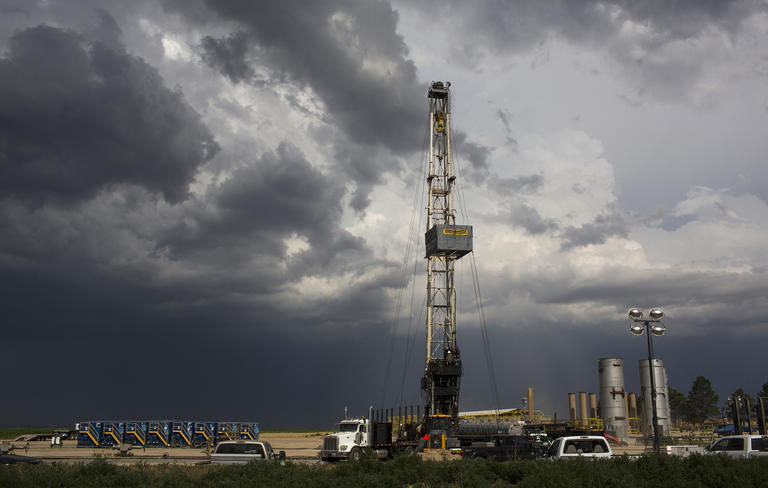Humans survive off of energyFrom powering homes and cars, to ensuring livestock are treated with care, everything that works in the modern age is dependent upon energy. One of the most prevalent methods of sourcing energy today is from fossil fuels. Cheap and easy to access, the infrastructure for these nonrenewable sources hold deep roots. Out of many, the one nonrenewable energy source that stands above all else is crude oil, an incredibly energy dense viscous liquid that can run anything from your engine motor to airplanes. Through years upon years of trial and error, humans have found an incredibly efficient method of extracting this power source; Fracking.
Fracking is a newer method of oil extraction, developed recently in the past twenty years as a way to extract crude oil from rocks, in which the oil and gas is typically trapped between the formations. Fracking itself works on the simple idea of hydraulics. By pumping liquid into an enclosed area, the pressure squeezes an object out of the area. Thus, by pumping water and numerous chemicals into a rock formation, fracking causes cracks to form within the rock, allowing the gas and oil to flow to the surface. In order to optimize hydrocarbon flow, fracking utilizes a specific blend of fluid that, according to the National Resource Defense Council (NRDC), typically composes ingredients such as methanol and ethylene glycol as well as numerous undisclosed chemicals. These chemicals are infamous for the danger they pose to human health, and are also known to spread in the surrounding area once distributed.
While fracking may already look pretty bad, that’s just the tip of the iceberg. One major concern regarding fracking is the impact on the water you use and drink. According to studies done by Duke University, fracking has consumed roughly 172 billion liters of water a year between 2012 to 2014, totaling 344 billion liters used. For comparison, the average household of 4 in Canada uses around 31000 gallons per year, meaning that over the course of a year they used over 10 million homes worth of water. From the same study, fracking resulted in a 770% increase in water well usage through the years 2011 and 2016, . Causing an almost 550% proliferation within the first year. Keep in mind, these water wells are scarce accesses to freshwater, thus exacerbating the issue of freshwater availability already present in many communities. Furthermore, fracking causes numerous chemicals to leak into the surrounding water. This leads to the spill of wastewater, produced by fracking, to leak into the surrounding water bodies before settling. Thus, not only affecting the drinking water of surrounding wildlife but also very importantly, the drinking water in people’s homes. In fact, in Bradford county it was shown that water could literally be lit on fire due to the methane present as a result of fracking sites near homes. Even worse, many fracking companies refuse to disclose these problems until they face lawsuits and public backlash, caring not for the safety of the public. In fact, despite countless evidence otherwise, the Independent Petroleum Association of America (IPAA) on their website still claim that fracking is nothing but a positive thing, causing no harm to public health or groundwater. With the dangers of fracking on the surrounding water, it’s clear that policies and laws must be reevaluated to tackle this massive issue.
The second hazard of fracking on the environment is how it pollutes the air. Like many other forms of energy extraction or energy usage, fracking requires copious amounts of resources in order to function properly. These sites release massive amounts of greenhouse gasses, mostly produced by the combustion engines used in heavy trucks machinery to prepare the site, as well as the pump itself. Furthemore, similar to how leakage of the fossil fuels contaminates the surrounding water source, the air around the site is not exempted from pollution either. Leaks of gasses, in particular Hydrogen Sulfide, a toxic and also highly explosive gas, leads to wide scale pollution that can cause numerous illnesses in people who breathe it in. One article released by Physicians for Social Responsibility found that in Northeastern Colorado, over 55% of exceptionally high VOC (Volatile organic compounds, toxic gasses released during the process of drilling and fracking) could be traced directly back to oil and gas mining operations. However, despite all these health risks, there is shockingly little regulation present within the oil and mining industry. For example, a report from the National Resource Defense Council found that out of over 3486 high priority wells, the Bureau of Land Management only investigated 40% of them between 2009 and 2012. In Texas, the problem seemed even worse with comprehensive action taken against only 2% of over 55000 logged violations. If not already clear, there is simply a lack of responsibility and understanding on the part of the federal government and fossil fuel companies on the effects their fracking has on the surrounding environment.
The problem is clear. Corporations lack the responsibility and empathy towards the people they are affecting with their work, high profits and intense lobbying further grant them pardons by both Federal and State governments in order to “protect the economy and bring back jobs”. It’s evident that, at the very least, they should protect surrounding communities or further yet, move away from fracking as a whole. However, without a change in power, this is nothing but a pipe dream, and something must happen in order for real change to occur. The Green Party, in particular, seeks to transition from fossil fuels to more sustainable forms of energy, something that in past years has yet to be seen done on a large scale.
Mullen, J. (n.d). The truth about fracking and the environment. The Wilderness Society. Retrieved August 5, 2022, from https://www.wilderness.org/news/article/truth-about-fracking-and-environment#:~:text=Hydraulic%20fracturing%2C%20or%20%E2%80%9Cfracking%2C,wild%20landscapes%2C%20and%20threaten%20wildlife
(2018, July 24) Fracking: What is fracking?: Shale Oil and Natural Gas: IPAA. Independent Petroleum Association of America. . Retrieved August 5, 2022, from https://www.ipaa.org/fracking/
Denchak, M. (2022, April 13). Fracking 101. NRDC. Retrieved August 5, 2022, from https://www.nrdc.org/stories/fracking-101
Glauser, W. (2014, May 13). New legitimacy to concerns about fracking and health. CMAJ : Canadian Medical Association journal. Retrieved August 5, 2022, from https://www.ncbi.nlm.nih.gov/pmc/articles/PMC4016083/
Meng, Q (2017). The impacts of fracking on the environment: a total environmental study paradigm. Mississippi State university. Retrieved August 5, 2022, from https://www.unco.edu/nhs/biology/about-us/franklin-scott/lab/images/Meng2017.pdf
Nardone, N. (2017). The Environmental Impacts of Fracking. DigitalCommons@University of Nebraska. Retrieved August 5, 2022, from https://digitalcommons.unl.edu/cgi/viewcontent.cgi?article=1269&context=envstudtheses
Hoffman, J. (2019, February 15). Potential Health and environmental effects of hydrofracking in the Williston Basin, Montana. Teach the Earth. Retrieved August 5, 2022, from https://serc.carleton.edu/NAGTWorkshops/health/case_studies/hydrofracking_w.html
Physicians For Social Responsibility. (n.d.). Hydraulic fracturing and your health: Air contamination . Retrieved August 9, 2022, from https://www.psr.org/wp-content/uploads/2018/05/fracking-and-air-pollution.pdf
Water Docs. (2021, May 25). The impact and consequences of fracking on Water Resources. Water Docs. Retrieved August 5, 2022, from https://www.waterdocs.ca/water-talk/2020/5/20/the-impact-and-consequences-of-fracking-on-water-resources Green, K. P., & Jackson, T. (2020, May 21). Blog: Is fracking safe? air quality. Fraser Institute. Retrieved August 5, 2022, from https://www.fraserinstitute.org/blogs/is-fracking-safe-air-quality#:~:text=We%20now%20turn%20our%20attention,the%20use%20of%20diesel%20generators




